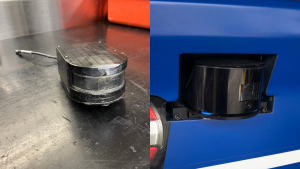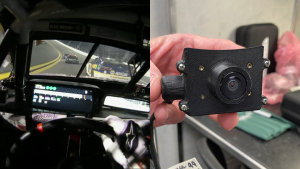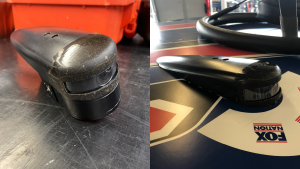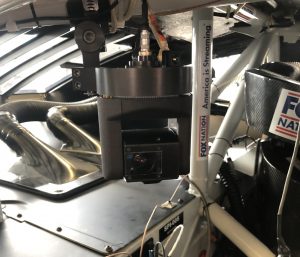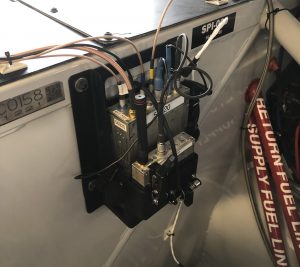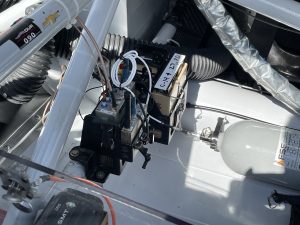Live From Daytona 500: BSI Adapts to Next Gen Cars With New Front, Rear Bumper Cams
The team worked closely with NASCAR to prevent complications with airflow
Story Highlights
As NASCAR enters its next phase of driver safety and car development, camera manufacturers are tasked with adapting to the changes. Broadcast Sports International (BSI), an NEP Group supplier high-quality POV cameras and RF services, may be the most affected entity. To answer the call, the company has developed a new front and rear Bumper Cam that puts the fan even closer to the grid.
“We started working with the individuals that were designing the Next Gen cars at NASCAR about two years ago,” says Peter Larsson, president, BSI. “The interior of the car has changed substantially, and we’re using a different mounting plate, so there was a lot of back and forth with sending them drawings of what we could build.”
MORE FROM DAYTONA 500
- Fox Sports Makes 2022 NASCAR Season Debut With 1080p HDR Broadcast, Massive Onsite Presence
- TD John Howard Pulls Double Duty at Super Bowl LVI, Super Bowl of Racing
- Fox Sports Studio Team Parks in Old Victory Lane for Stunning Backdrop
- SMT Amplifies Fox Sports’ New Graphics Package With Heart Rate Telemetry, Real-Time Position Tracking
- Beverly Hills Aerials Takes to the Sky With FPV Racing, Heavy Lift Drones
- Fox Sports Will Still ‘Crank It Up’ for the Iconic Race
- Game Creek Video Readies Encore Mobile Unit for NASCAR on Fox Season Opener
Collaborative Discussions: NASCAR, BSI Find Competitive Sweet Spot

From left: Peter Larsson, Alexander Meszaros, Nate Lowe, Robert Crow, and Tom Grigsby in front of BSI’s hauler in the infield at Daytona International Speedway
Any piece of technology added to the car needs the blessing of NASCAR’s operations team. Since these new Next Gen cars are constructed in a different way and are being introduced for official races this season, the biggest challenge was the Bumper Cams’ potentially compromising the integrity of the car. In collaboration with Managing Director, Aerodynamics and Vehicle Performance, Eric Jacuzzi and other key members of the NASCAR team, Larsson and his BSI crew aimed to avoid any sort of hindrance to the driver.
“Testing was very difficult because we needed to make sure the camera wasn’t stopping the natural air flow of the car,” he says. “NASCAR didn’t want any air going through and under the car because that would be a different scenario from the cars that weren’t running them.”
To ensure that the playing field was even, models were created, thrown away, and revised. Ultimately, the collaboration produced a piece of hardware small enough to not affect the aerodynamics of any participating car while fitting snug into the car’s body. Like other robotic POVs, the cameras can pan left to right and track the traffic next to, in front of, and behind the car. In addition, a long enough cable was supplied to attach the device to the main equipment plate on the inside of the car and prevent it from flying away from the car after impact. For example, the front Bumper Cam on Joey Logano’s No. 22 car sustained minor damage after he collided with the wall near the conclusion of the second duel on Thursday night. Although it takes 45 minutes to install into the car, the team has 20 backup cameras if one isn’t able to be fixed.
Although these Bumper Cams are the main attraction, BSI will be operating its customary arsenal of POV cameras in the car and around the track. As with previous runs of the Daytona 500, in-car cameras will include a stationary POV capturing the face and body of the driver and a handful of Visor Cams focused on the driver behind the wheel. Roof Cams will also return to provide a vantage point from atop the car. And BSI will support a pair of DreamChip POVs: one at the curve between Turns 1 and 2 and another at the straightaway after Turn 4. The feeds will be operated out of NEP’s new SRT3 mobile unit.
“With the new transmitters that we’re building for the onboard cameras,” says Larsson, “we can have multiple video feeds through a single 8-MHz-wide signal. “]We’ve also created an encoder to do two or three videos through that one 8-meg signal.”
Back in a Packed House: Crew Sidesteps RF Disruptions
For one of the most crowded events in American sports, BSI will have to deal with a massive influx of cellular congestion as fans return to Daytona International Speedway. It’s a hurdle the team is used to leaping, but, after last year’s limited-capacity attendance, \ RF congestion is is once again a concern. Fortunately, these cameras and solutions are operating on a different frequency.
“As fans come in,” he explains, “the Wi-Fi band becomes almost unusable, so we stay away from that. We always operate on a secondary, non-interfering basis. As we go higher [up the spectrum], we need two to three times the number of antennas around the track.”
Along with the bevy of wearable POVs and robotics, BSI will be responsible for a few other cameras. Three Sony HDC-5500’s will be used as RF handhelds in the pits, but, more notably, the company will provide connectivity for the Megalodon (a Sony A7iii) roaming in the same area. All of this technology will play a vital part in Fox Sports’ 1080p HDR production of the race, but the camera feeds will be joining the 1080p HDR wave at another time. When the time comes, these 1080p workflows will be deployed for up to 10 cars (with four cameras each), a handful of virtual-reality cars, and the rest of the field being used for the internet feed.
“These cameras are capable of 1080p, but the current encoders in the car are not,” says Larsson. “We’re still encoding in 1080i, and we were building to get ready to go to 1080p, but we ran into supply-chain issues.”
